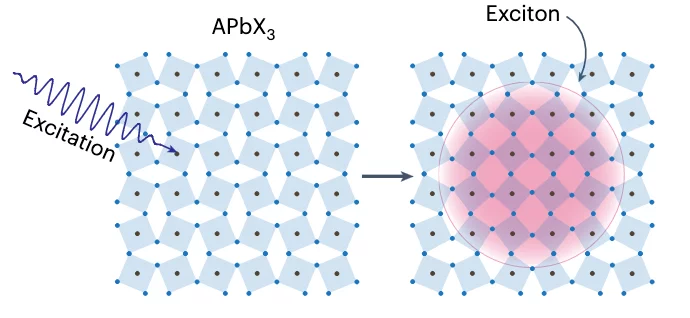Understanding the origin of electron–phonon coupling in lead halide perovskites is key to interpreting and leveraging their optical and electronic properties. Here it is shown that photoexcitation drives a reduction of the lead–halide–lead bond angles, a result of deformation potential coupling to low-energy optical phonons. This is accomplished by performing femtosecond-resolved, optical-pump–electron-diffraction-probe measurements to quantify the lattice reorganization occurring as a result of photoexcitation in nanocrystals of FAPbBr3 (FA= formamidinium). The results indicate a stronger coupling in FAPbBr3 than CsPbBr3. The enhanced coupling in FAPbBr3 is attributed to its disordered crystal structure, which persists down to cryogenic temperatures. The reorganizations induced by each exciton in a multi-excitonic state constructively interfere, giving rise to a coupling strength that scales quadratically with the exciton number. This superlinear scaling induces phonon-mediated attractive interactions between excitations in lead halide perovskites.
Contact
Dr. Antonio Cervellino
Beamline Scientist
PSI, Laboratory for Condensed Matter in the Photon Science Division
Forschungsstrasse 111, 5232 Villigen PSI, Switzerland
Telephone: +41 56 310 4611
E-mail: antonio.cervellino@psi.ch
Original Publication
Coupling to octahedral tilts in halide perovskite nanocrystals induces phonon-mediated attractive interactions between excitons
N. Yazdani, M. I. Bodnarchuk, F. Bertolotti, N. Masciocchi, I. Fureraj, B. Guzelturk, B. L. Cotts, M. Zajac, G. Rainò, M. Jansen, S. C. Boehme, M. Yarema, M.-F. Lin, M. Kozina, A. Reid, X. Shen, S. Weathersby, X. Wang, E. Vauthey, A. Guagliardi, M. V. Kovalenko, Vanessa Wood, and A. M. Lindenberg
Nature Physics 2023

